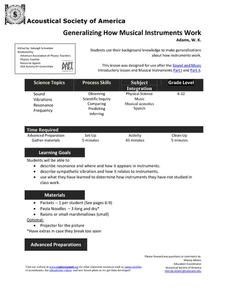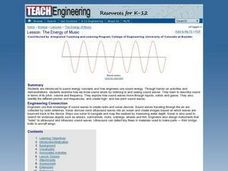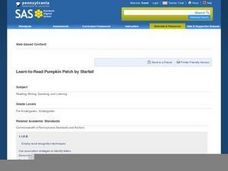PBS
Math with Jake: Frequencies and Pitch
Be an octave above the rest. A musician explains how to write music in different time signatures. An interesting resource continues to demonstrate ratios using the pitch of musical notes and hertz. Pupils use a pitch table and determine...
PBS
Math with Jake: Transposition Using Ratios
The star of the show is ratios. The informative resource explains how to transpose music using ratios. Individuals transpose the song "Twinkle, Twinkle" in the activity by applying their ratio skills. The activity challenges class...
California Department of Education
What Is a "Wave"?
Take a stretch, but don't wave goodbye. An interesting resource provides everything needed to present an introductory lesson plan on waves. Teachers present a PowerPoint defining the types of waves and their characteristics. Pupils use a...
Curated OER
Vocabulary Lesson (Color Words) Using Various Books by Eric Carle and Internet Sites
Students investigate color words. In this vocabulary, high frequency words, and technology lesson, students visit various websites to practice reading color words. Students listen to Eric Carle books and observe the illustrations,...
Curated OER
The Science of Sound and Musical Instruments
Students identify the components of sound. They describe the relationship between pitch and frequency and explain the terms sympathetic vibrations and resonance.
They perform simple experiments about the world of sound and explain the...
Acoustical Society of America
Musical Instruments
Mix it up and engage learners in a lesson on music and physical science. Using cups, strings, guitars, and voice, the class will experiment with sound vibration and frequency. They'll use each instrument and fill out a worksheet that...
Curated OER
Sounds Like Science-Guitars
Young scholars demonstrate the relationship between a sound and its frequency. In this sound and frequency lesson, students use an old tennis racket and nylon fishing line to create a guitar. Young scholars observe the pitch and frequency.
Curated OER
How Often? Where is it?
Students explore language arts by completing vocabulary worksheets. In this directions lesson, students identify terms and vocabulary words which assist in finding locations and giving directions. Students complete a worksheet about the...
Acoustical Society of America
Generalizing How Musical Instruments Work
Sound, vibrations, resonance, and frequency are explored as learners use music to foster scientific inquiry. They engage in three different sound experiments and follow up discussions to foster a better understanding of how musical...
Curated OER
Comparing Notes: a Mathematical Exploration of the Piano
Students examine the history of equal temperament, the modern standard of tuning a piano. Proportion calculations of octaves and perfect fifths are utilized to calculate the frequency of each note in a major scale.
Curated OER
Sounds Like Science- Jamboree
Learners explore sound, pitch, volume, frequency, and musical notes. In this homemade instrument activity, students use materials such as jars, buckets, strings, rackets, rubber bands, and bottles to create their own unique instrument....
Curated OER
Compound Word Frequency
First graders explore English by participating in a vocabulary activity. In this compound word lesson plan, 1st graders define what a "compound word" is and read several examples of them. Students utilize a stack of flash cards to...
Curated OER
Pitch
Second graders investigate the concept of pitch and how it can be changed in its duration and frequency. They use rubber bands and cardboard to demonstrate different sound patterns. Students are asked to recognize how vibration varies...
Purdue University
Design of Music Instruments for a Rock Band
Can you create a rock band? Scholars learn about the creation and transmission of sound in a hands-on STEM activity. First, they explore the transmission of sound using a tuning fork. Then, they must solve the problem of missing...
Acoustical Society of America
Musical Instruments: Part II
String together how instruments produce sound. Using pieces of string, learners find ways to create sound. They investigate changes to the string and the effect of adding a cup. Finally, pupils experiment by changing the way to create...
California Department of Education
Waves and Music
Strike the right chord with a musical activity! Instructors provide a lecture on the mechanics of a pan flute. Pupils build their own pan flutes by using straws and calculating the lengths to create a scale. After cutting the straws to...
California Department of Education
Slap Tubes, Flutes, and Xylophones: The Physics of Pipe-Based Instruments
It's the encore to a wave unit. Individuals build either a slap tube, flute, or xylophone as a culminating activity for a physics unit on waves. Scholars calculate the lengths of pipes needed to produce the specific notes for their...
Curated OER
The Energy of Music
Students discover how engineers use sound energy. They participate in hands-on activities in which they discover how we know sound exists. They identify different pitches and frequencies as well.
Curated OER
Mathematical Models with Applications: The Sounds of Music
Students use an electronic data-collection device to model the sound produced by a guitar string. They identify the graph of a periodic situation and use the graph to determine the period and frequency of sound waves.
Curated OER
Sounds Good to Me
Students determine density and hardness of wood samples based on several investigations. In this physical science and music instructional activity, students visit four centers and perform tests on wood samples to determine densities and...
Curated OER
The Cigar Box Guitar
Pupils correlate string tension with sound pitch. They describe how string mass (thickness) effects sound pitch and demonstrate an understanding of the physics of the acoustic guitar. They see that sound is produced by vibrations.
Curated OER
Strum Along
Students engage in a instructional activity which takes something constructed by the class, that would be normally classified as just sound, then work together to make what can be perceived to be music. Students construct a basic...
Explore Sound
Sound and Music
What causes sound? Groups of sound detectives use a variety of tools including ping pong balls, pasta noodles, raisins, rubber mallets, and a tuning fork to investigate what causes sound. The young Sherlocks conduct a series of...
Curated OER
Learn-to-Read Pumpkin Patch
Students practice identifying and pronouncing the short letter "u" sound. In this phonetic awareness lesson, students access the Starfall.com website and follow the directions on the screen to reinforce the short "u" sound. Students can...
Other popular searches
- High Frequency Word Games
- Frequency Tables
- High Frequency Words
- Frequency Adverbs
- Adverbs of Frequency
- Frequency Tables Line Plots
- Mean Mode Frequency Table
- Tally Chart
- Frequency Distribution
- Read High Frequency Words
- Wavelength and Frequency
- Frequency Chart

























